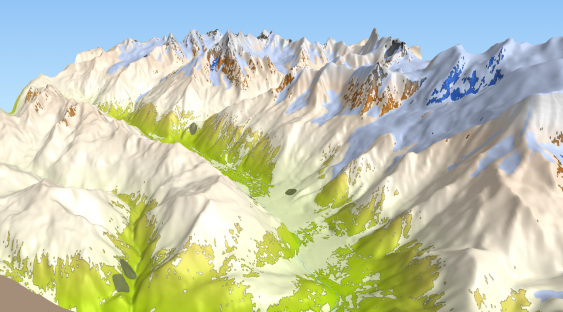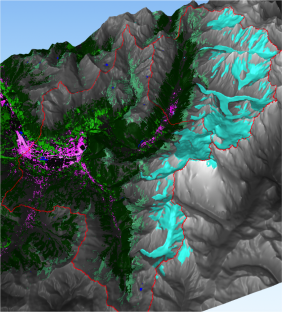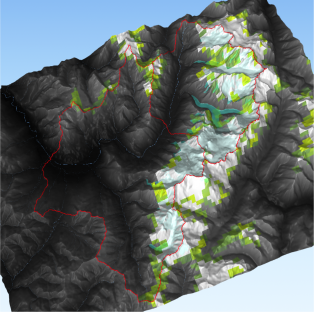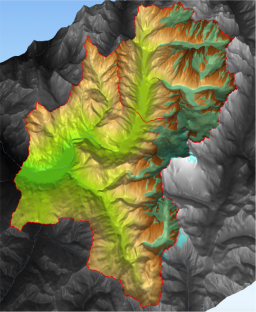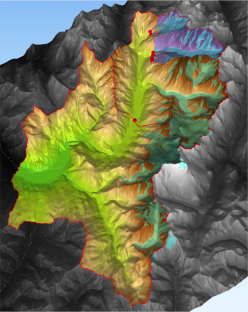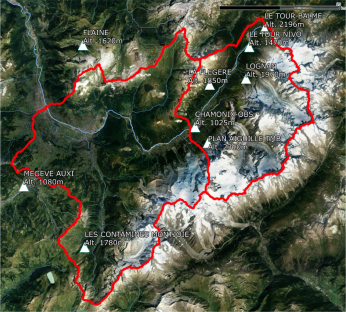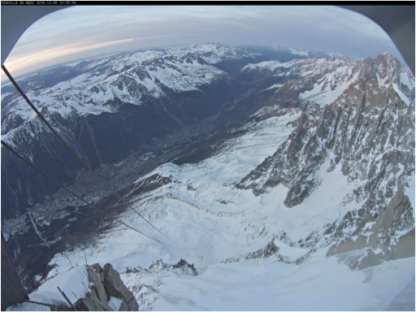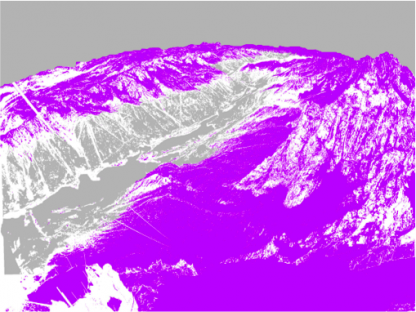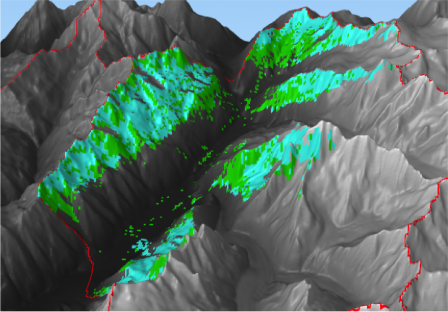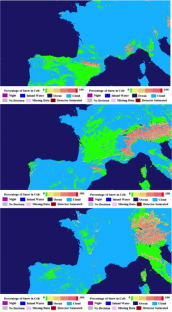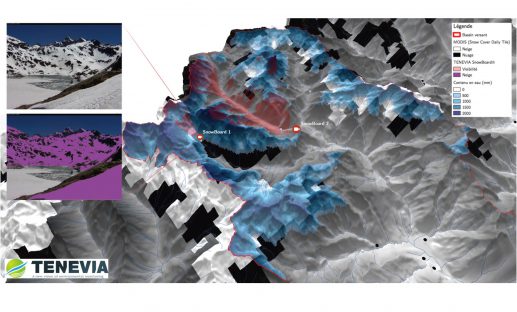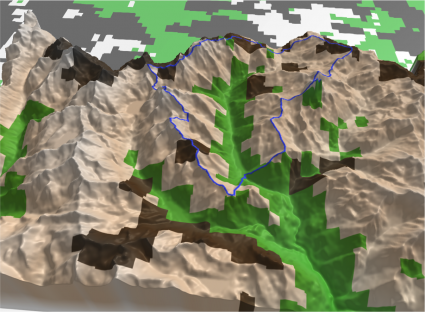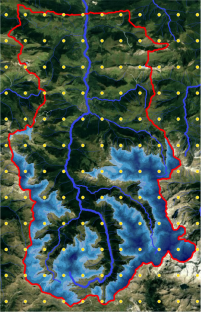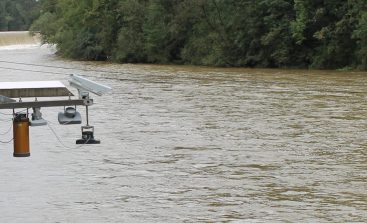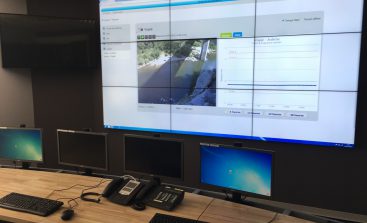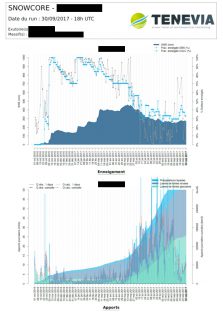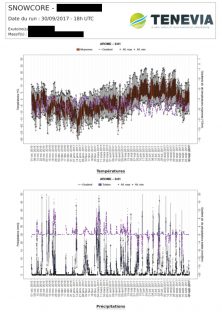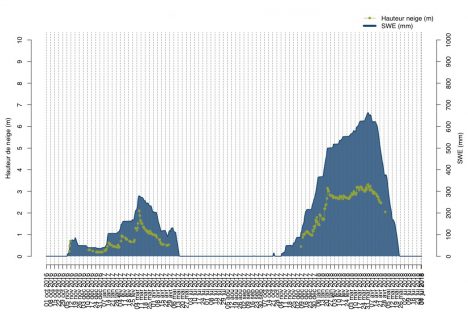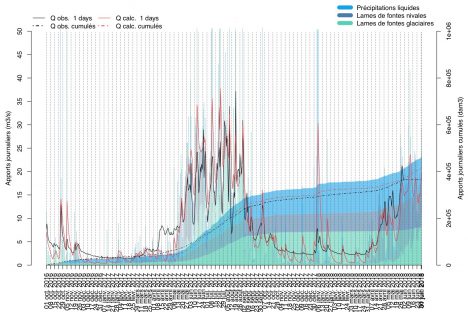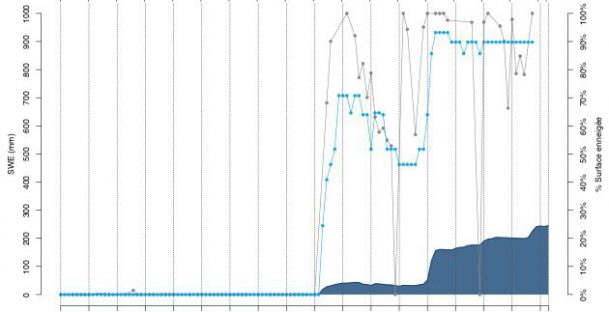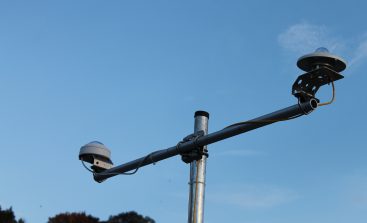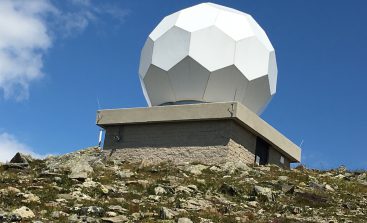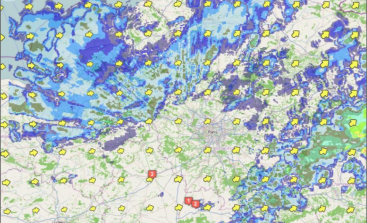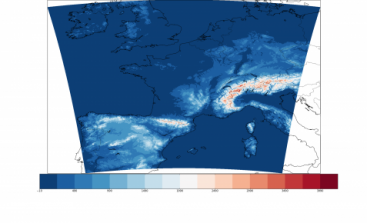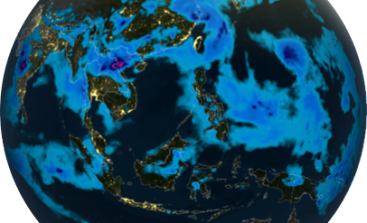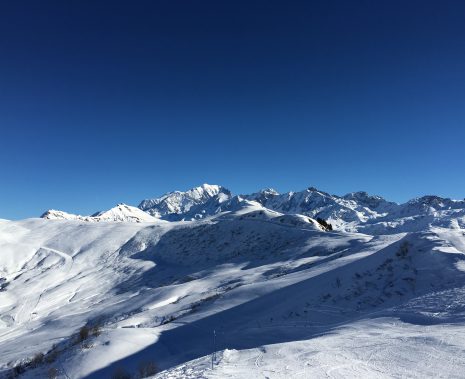TENEVIA SnowCore® is a simulator that quantifies and anticipates ice and snow melt.
It is generally used in the operation of hydropower structures, water management, carrying out studies and diagnosing hydropower potential or flood forecasting when coupled with the HydroCore simulator.
AN OVERVIEW OF SNOWCORE
TENEVIA SnowCore® allows you to anticipate the accumulation and melting of snow and glaciers, according to the weather conditions observed and/or forecast. The simulator produces different data flows for snow and ice for the area of interest (mountain slope, catchment, region etc). Based on a detailed representation of the spatial distribution of the snow and ice water equivalent, it provides the characterisation of these contributions to mountain hydro systems.
Designed for operational snow and glacier simulation, the SnowCore model integrates a territory’s available spatial data (topography, land use, etc.). It also draws on a considerable variety of measurements linked to the snow cover, from remote sensing to in situ measurements. The model therefore adapts automatically to each catchment area. Its application in real-time forecasting or offline analysis uses a number of observed or forecast meteorological data sources. The main uses for the SnowCore simulator are for managing hydropower facilities, flood forecasting, diagnosing and studying water resources and requirements, studying hydropower potential and studying hydraulicity.
ADVANTAGES OF SNOWCORE
Turnkey service
SnowCore makes snow and ice data flows easy to access in real time. It is TENEVIA that manages the model’s operational function. Proposed as a service, the user does not need any specific computer infrastructure to use it.
Operational function optimised
SnowCore is designed for optimum function in operational conditions. A numerically effective system, this spatialised model works rapidly, taking from a few seconds to a few minutes depending on the size of the catchment area or massif concerned. Refresh frequency is usually hourly.
The reasoned representation of the main physical processes of snow and ice melt allows SnowCore to operate with very little historical data.
It uses the available data
Designed to be modular, SnowCore adapts to each mountain region’s specificities. The simulator takes the spatial variability of the topographical properties into account, such as the altitude, the slope aspect (relative to the sun) or the land use. The simulator therefore considers Ice-covered, forest and urban zones differently.
SnowCore understands perfectly how to use a large quantity of existing data. This allows the model to improve the precision and strength of its simulations and forecasts. It can also function in a pertinent manner with little data.
Compatible with a large quantity of meteorological data
The snow pack is location-sensitive to meteorological phenomena that vary according to the altitude, the slopes and valleys, etc. SnowCore therefore takes into account the spatial variability of temperature and precipitation. To do this, it uses different observed and simulated data sources on temperature and precipitation, from:
- measurements produced by a network of weather stations;
- forecasts put together using high-resolution weather models, like Météo France’s AROME model;
- quantitative precipitation estimates from weather radars if they are pertinent in the considered zone due to masks caused by the relief.
TENEVIA is a partner of many weather station manufacturers and suppliers and uses forecast data from weather models or radar observations. For more information, please contact us.
Self-adjusting forecast through data assimilation
SnowCore can use a wide variety of snow cover related measurements to improve its forecasts. Observations from satellite remote sensing (MODIS, Sentinel), close-range remote sensing (videos cameras) or ground stations can also be integrated into the simulator. The assimilation of those various observations enables the detection and correction of deviations with the appropriate adjustments. This type of technique has allowed significant progress to be made in operational meteorology.
Functions enriched by our web services
TENEVIA helps you to use snow and ice data flows through its TENEVIA OS supervision service. Based on high-availability servers hosted in France, this service allows you to benefit fully from the advantages of a snow monitoring and forecasting system:
- data storage;
- concentration of meteorological input data;
- concentration of snow, ice and water-level measurements (satellite, existing sensors, CamFlow, etc.)
- supervision of model operation;
- access to an advanced email and text alert module;
- real-time consultation and access to historical data (dashboard).
Further information in our Web Services section.

request

OPERATION AND SERVICE LEVELS
| ESSENTIAL | ADVANCED | COMPLETE | |
|---|---|---|---|
| Simulations / Forecasts of the water content of the snow pack and melt yield | |||
| Forecast with data assimilation | |||
| Forecast with quantification of uncertainty |
| ESSENTIAL | |
|---|---|
| Simulations / Forecasts of the water content of the snow pack and melt yield | |
| Forecast with data assimilation | |
| Forecast with quantification of uncertainty | |
| ADVANCED | |
|---|---|
| Simulations / Forecasts of the water content of the snow pack and melt yield | |
| Forecast with data assimilation | |
| Forecast with quantification of uncertainty | |
| COMPLETE | |
|---|---|
| Simulations / Forecasts of the water content of the snow pack and melt yield | |
| Forecast with data assimilation | |
| Forecast with quantification of uncertainty | |
Discover SnowCore’s operating principle, a spatialised model simulating ice-snow melt.
TECHNICAL PRINCIPLES
Description of the model
TENEVIA SnowCore® is a digital tool that simulates the effects of meteorological forcings on the water content in snow packs and glaciers. SnowCore is a spatial model based on an empirical representation of snow and ice processes. It divides each slope and each massif into several spatial entities using topographical (altitude, exposure, etc.) and hydrographical (glaciers, catchment areas) criteria. It represents the behaviour of stocks of snow and ice on a local to regional scale.
Representation of the ice and snow processes: SnowCore takes the spatial variability of the ice and snow processes into account. Their representation is achieved using different processes:
- spatialization of the forcings (temperatures and precipitation) according to topography;
division of precipitation into rain and snow, if this is not already known; - a snow melt module simulating the spatial and temporal dynamic of the snow water equivalent;
- a module of ice melt on the glacial zones simulating the spatial and temporal dynamic of the ice water equivalent;
- a calculation of the water content combining rainfall, snow melt and glacial melt
SnowCore’s continuous operation prevents the initialisation issues (i.e. period of the initial condition of the snow) that are characteristic of operation in Event mode.
Initial calibration of the model
When setting up SnowCore, different information elements can be integrated, such as the topography (using a digital terrain model) or the land use. Once structured and adapted to regional specificities, SnowCore can be calibrated. The calibration stage is a “learning” phase during which the model can complete its adjustment to the characteristics of the forecast site. During this step, the different parameters governing SnowCore’s operation are calibrated to reduce the differences with historical data. This data, which is first investigated, is provided by the client and/or collected by TENEVIA.
Real-time adjustment through data assimilation
A model is only a simplified and imperfect representation of the real snow, ice and water conditions. For many reasons, during the operational forecast phase, differences are usually observed between the behaviour simulated by the model and the behaviour observed on the terrain using the measurement network, or remotely using remote detection, for example.
The main sources of errors come from uncertainty regarding the precipitation and the parameters calibrated to represent a mean behaviour, as well as incorrect representativity of the model.
To limit the impact of these uncertainties, SnowCore’s data assimilation module carries out a self-analysis at a moment (t) of the differences between the simulations and the observations over a period of time (P). This result allows SnowCore to adjust certain of the model’s condition variables at t-P, such as the snow’s water content. Using this condition adjusted at t-P obtained through optimisation, SnowCore can make a new forecast through to the time step t+F, where F is the forecast horizon. SnowCore’s assimilation module can also intervene in adjusting certain other model parameters like, for example, those governing the rapidity of the melt under the effect of the temperatures.
SnowCore does not simply make an error correction by post-treating simulations (therefore without any effect on the following time steps) but implements a real strategy that will make a lasting correction of its trajectory. Strategies are implemented to remove outliers and ensure the model’s stability. A regularisation process is integrated to avoid problems of over-adjustment and behaviour instability.
Quantifying uncertainties
The main causes of uncertainties when forecasting snow and glacial melt are due to errors in forecasting temperatures and precipitation and in SnowCore’s calibrated parameters. To quantify the forecast uncertainties, different weather evolution scenarios are disseminated in the simulator. For each of them and for different combinations of parameters, SnowCore emits a melt forecast.
Operation and service levels
SnowCore is deployed on an application server (cloud computing) administered by TENEVIA. It centralises all the data required for the model’s operation in real time (e.g: weather forecasts and assimilation data). SnowCore can produce melt yield forecasts at multiple points of interest chosen by the user and called Virtual Stations.
The SnowCore simulator offers three levels of service.
Essential: Forecasts the snow-ice melt and the distribution of the water content in the snow pack, using measurements and/or temperature and precipitation forecasts.
Advanced: Forecasts with data assimilation to correct any deviations from the model.
Complete: Forecasts with data assimilation and quantification of uncertainties (ensemble forecast).
FAQ & FURTHER INFORMATION
What data must I transmit to benefit from the SnowCore service?
SnowCore does not require any particular data from the user. A large quantity of environmental data is currently available worldwide and in Europe (Inspire directive). TENEVIA collects the topographical, meteorological, spatial, nivological, glaciological and hydrometric data. SnowCore also uses the user’s data such as high-resolution digital terrain models (DTM), weather stations, video cameras, flow stations, etc… To guarantee SnowCore’s operation, the user only has to transmit the location of his desired virtual stations.
To improve its quality of forecast, TENEVIA proposes different services. To find out more, see the “Weather Data” section for SnowCore or our sensor systems.
What lead time should be envisaged?
SnowCore uses weather forecasts to anticipate the evolution of the snow pack and the glaciers. The forecast horizon is heavily dependent on the weather forecast source(s) used. By using weather models such as AROME, WRF, NEMS, ARPEGE or GFS, SnowCore can generate forecasts going from 42 hours up to 7 days. SnowCore can also integrate seasonal climatological trend forecasts. The notion of uncertainty of the forecast calculated by SnowCore is essential here for the most precise use of the snow and ice information.
Does SnowCore forecast discharge?
SnowCore focuses on nivology and glaciology. It does forecast ice-snow melt, which it can combine with that of liquid precipitation. River discharge is caused by the effect of the catchment area’s hydrological processes on these different water contributions. This role is covered by TENEVIA’s HydroCore® simulator, which can be combined with SnowCore to forecast river and mountain stream discharge.
What applications is SnowCore used for?
The SnowCore model can be implemented to monitor and forecast the evolution of the snow pack, manage hydropower facilities and to carry out water resource diagnoses and studies on the impact of climate change on snow conditions and the glaciers. Combining it with the HydroCore simulator extends its applications to forecasting floods and low water levels, pre-determining extreme discharge, simulating discharge to fill gaps in data and reconstituting historic flow series, as well as assessing a region’s hydropower potential.
Weather stations, rain gauges, radar nappes, high-resolution forecasts (…)
See a summary of TENEVIA’s meteorological solutions available on a subscription or rental basis and manufactured by our partners –weather stations suppliers and weather data producers.




